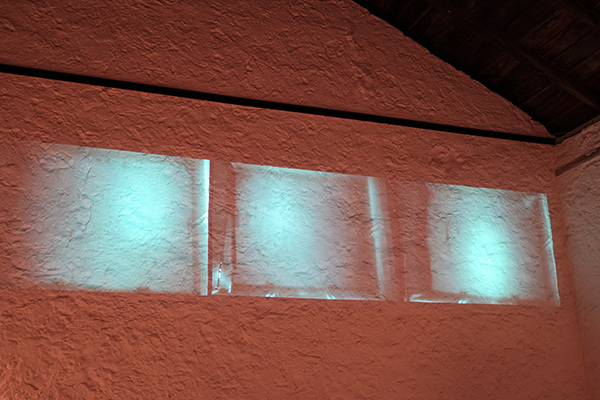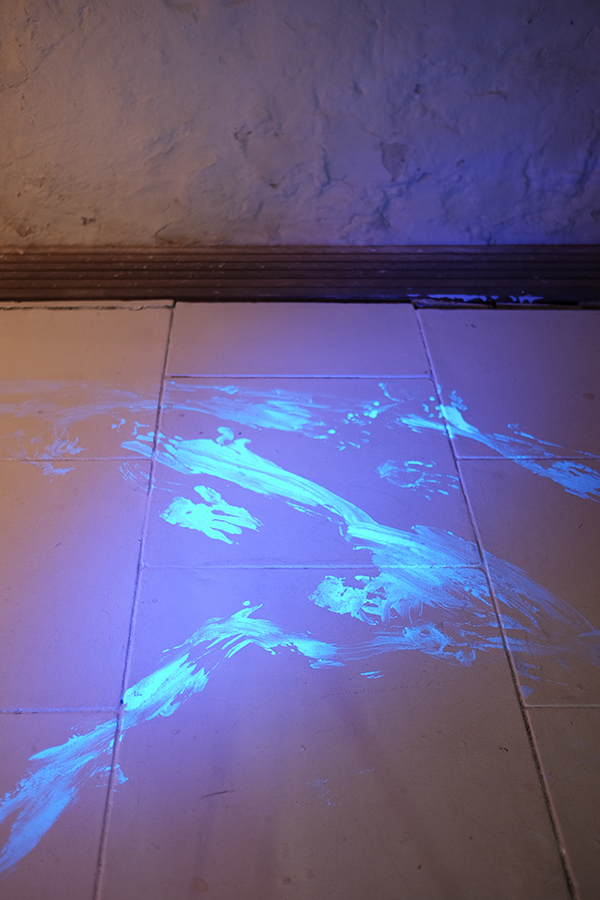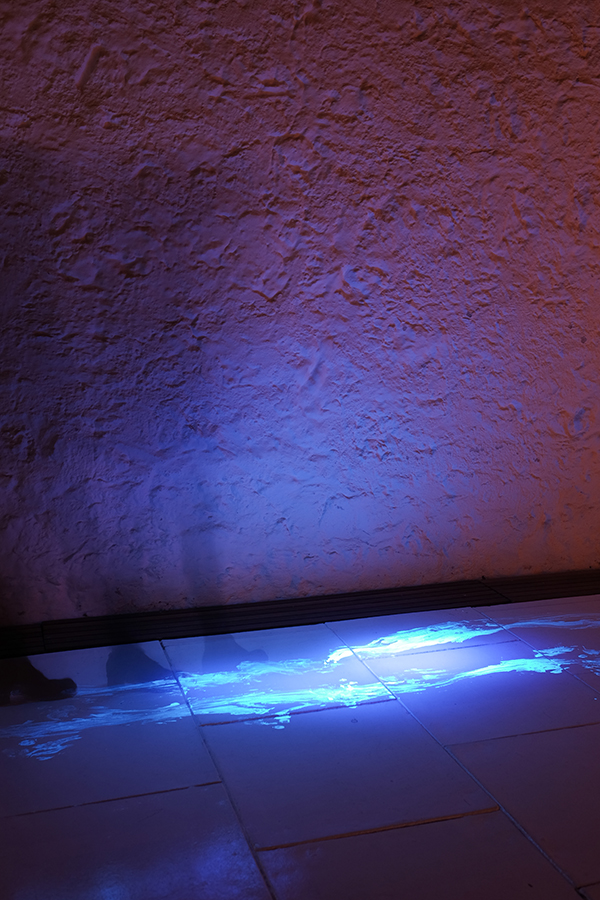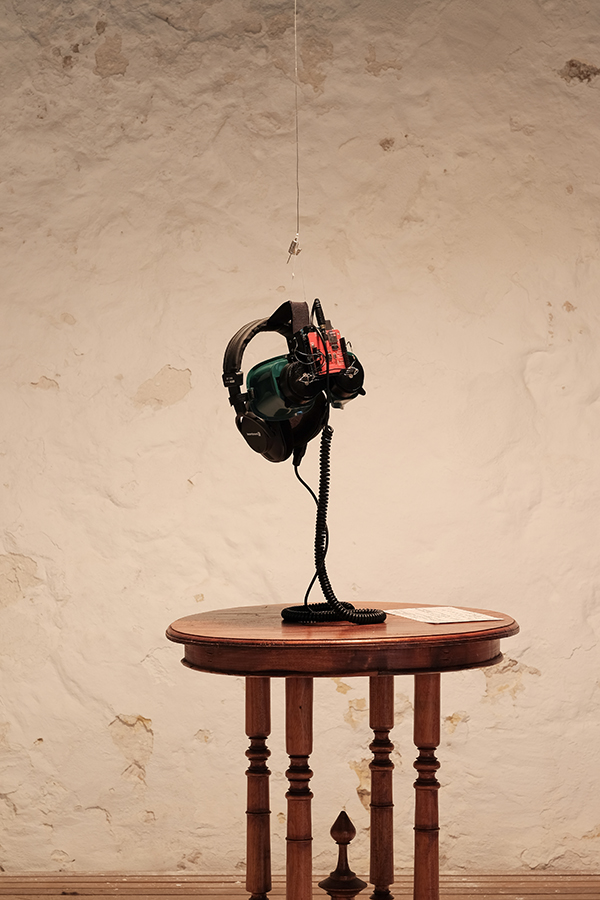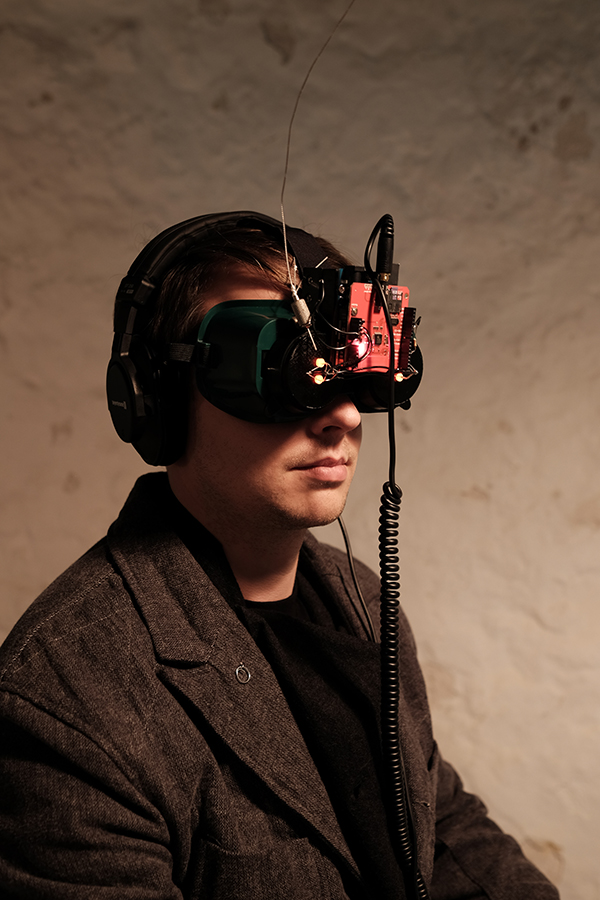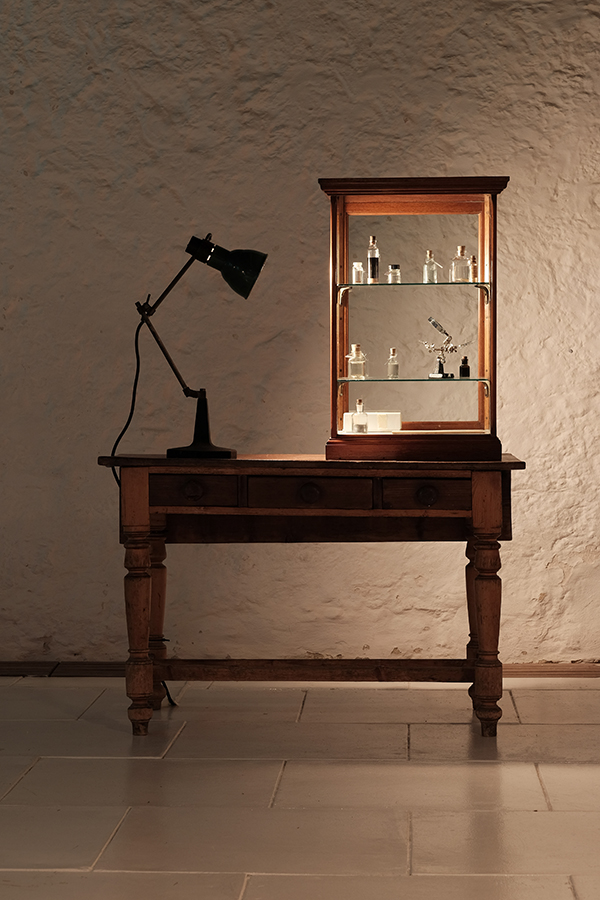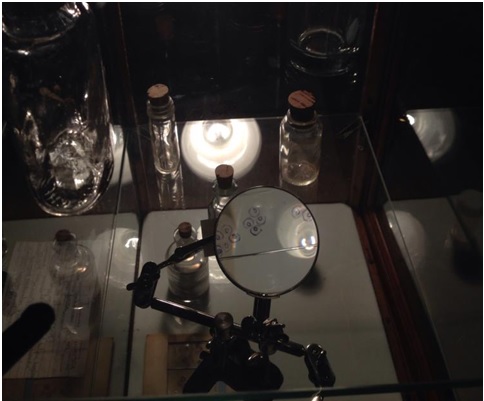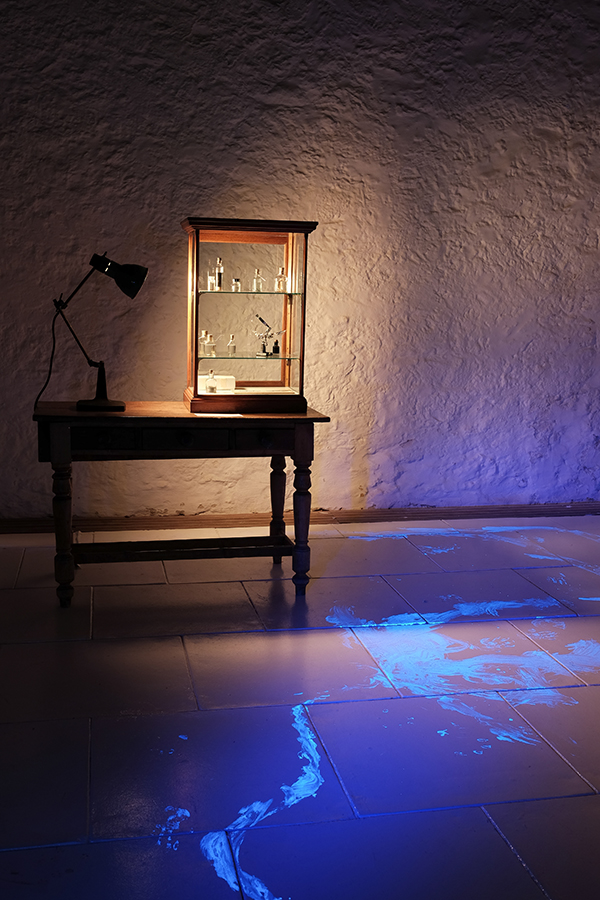Cernentia
—Integrating Science and Art to Explore the Visual Perception of Lungfishes without Eyes
Audrey M. Appudurai, Ionat Zurr & Shaun P. Collin
The visual perception of any organism is multifaceted, and can be explored and understood in a variety of ways. In scientific research, perception (visual, in this case) is investigated through a reductionist approach where the organism or species is ‘broken’ into smaller parts and defined within a strict set of rules that govern scientific methodology (Latour & Woolgar, Laboratory). These methodologies create a framework for obtaining a general and mechanistic understanding of the visual anatomy and perception of organisms that is detectable by means which aim at ‘removing’ the human biases and acquiring objective data through human-designed technologies (e.g. microscopy, electrophysiology).
However, understanding the visual experience of any animal, including lungfishes is problematic and inherently anthropocentric because our interpretations of the knowledge obtained through scientific experimentation are always informed by our own cognitive apparatus. Thomas Nagel acknowledged the failings of human cognition in this respect, saying, ‘Yet if I try to imagine (what it is like to be a bat), I am restricted to the resources of my own mind, and those resources are inadequate to the task’ (Nagel, ‘What’, 439). Jakob von Uexküll, who described the subjective experience of individuals as an Umwelt (plural: Umwelten), also touched on this futility, describing the ‘soap-bubbles’ of the Umwelt as inaccessible worlds where ‘certain, convictions are able to bar the entrance to those worlds so securely that not even one ray of all the splendour that spreads over them can penetrate it’ (Uexküll, Foray, 41).
Hence, no complete depiction of the visual perception of nonhuman animals is possible due to the embedded subjectivity of the organisms. Nevertheless, attempts to demystify visual perception are important and insightful, particularly if research utilises heterogenous perspectives from multiple disciplines (scientific, cultural, and art-making) that reveal the anthropocentric gaps in our understanding. Engagement with the Other can be done in many ways, and should not be exclusive to any single discipline. When investigating subjective experience, the objectivity of science can be ‘a direction in which the understanding can travel’ (Nagel, ‘What’, 443), and as C.P. Snow elaborates, ‘the clashing point of two subjects, two disciplines, two cultures—of two galaxies, so far as it does—ought to produce creative chances’ (Snow, Two Cultures, 16). Here, this approach creates a multi-disciplinary discourse which regards the strengths and weaknesses of each discipline as equally important (see Anderson, Truth; Mullen, Truth). Furthermore, this multi-disciplinary approach reflects the limitations and biases embedded in our own normative modes of how we perceive the world around us.
Donna Haraway, Gilles Deleuze and Félix Guattari approach the limitations of the sciences and the arts by addressing the gap between humans and non-human animals in order to better understand the world. For them, the attempt to ‘perceive’ like the Other (non-human animal) involves tearing down pre-conceived notions about what it is to be human. They believe that there is a growing need for humans to reconnect with the environment and become ‘more worldly’ (Haraway, When, 5). Deleuze and Guattari described this process as ‘becoming animal’; the human being’s opportunity to think themselves ‘other-than-in-identity’ and provide ‘the way out, the line of escape’ (cited in Baker, Postmodern, 125, 129). Haraway described the will to better know the non-human as a way to understand that the human species is part of—and interdependent on—the environment as all animals are, and refute the anthropocentric assumption that we have dominion over it (see her Simians).
The importance of this ‘becoming animal’ process lies in the opportunity to think differently about humans and animals. It is to leave the purely human and directly engage with the Other (be it animal or its environment, for the purpose of paper) to gain new understanding (Deleuze & Guattari, ‘Becoming-Intense’; Baker, Postmodern). Deleuze and Guttari write,
the relationships between animals are object not only for science but also of dreams, symbolism, art and poetry, practice and practical use... [and] are bound up with the relations between man and animal, man and woman, man and child, man and the elements, man and the physical and microphysical universe. (‘Becoming-Intense’, 259)
Posthumanism is the underlying philosophy that grounds not only Haraway’s and Deleuze and Guattari’s work, but Audrey Appudurai’s research and art-making. Posthumanism began as a cynical observation of how ‘aimless and arbitrary’ human intellect appears in the natural world. This aimlessness is increasingly more evident as we become more aware that the humanist perspective, which privileges humanity above all other forms of existence, will not prevent our extinction (Heidegger, ‘Letter’; Wolfe, Posthumanism). This recognition of humanism’s short comings proposes an urgent need for a new, less anthropocentric kind of thought, and positions humans as part of, connected to, and interdependent within the environment. If humanism is the belief that humans are the pinnacle of existence, then posthumanism is a philosophy that rethinks the position of humanity, and recontextualises it in terms of other species (Wolfe, Posthumanism).
For Cary Wolfe, posthumanism is ‘acknowledging that we are fundamentally prosthetic creatures that have co-evolved with various forms of technicity and materiality, forms that are radically ‘non-human’ and yet have nevertheless made the human what it is’ (xxv). The posthuman aspires to understand the world from multiple, heterogeneous perspectives and manifest him/herself in consideration with the different identities. Deleuze and Guattari’s ‘becoming animal’, however, is positioned purely at the philosophical level. Although they suggest a way to leave the human by inventing an ‘animal personality’, they do not engage with scientific concepts that might be useful to accomplish it. In contrast, Haraway, who has a PhD in primatology, engages with both the sciences and the arts to further human knowledge about our connection to non-human animals. Conversely, again, Appudurai’s research incorporates art-making across a variety of media as a tool to access the visual experience of lungfishes and embody processes of communication which engage an array of senses beyond verbal and cognitive including, sight, hearing, and touch. While it is important to critique the humanist foundations of scientific experimentation to reassess humanity’s position in the world, Appudurai would like to, at the same time, acknowledge scientific research as an important tool to further knowledge about the non-human animals.
This paper contextualises and examines the art project Cernentia by biologist and artist Audrey Appudurai, exhibited at Kidogo Art Institute, Fremantle, Australia in July 2015. Cernentia was generated by scientific and artistic research into the visual perception of a small, abnormal group of Australian lungfishes (Neoceratodus forsteri) that were born without external eyes.
Lungfishes are large, freshwater, lobe-finned fishes that have the ability to breathe both dissolved and atmospheric oxygen through gills and ‘primitive’ lungs, respectively. Six species of lungfishes remain worldwide; four in Africa (Protopterus spp.), one in South America (Lepidosiren paradoxa), and one in Australia (N. forsteri). The South American and African species inhabit lentic (lakes, or standing water) and lotic (river, stream, or running water) environments (Greenwood, ‘Natural’), and swamps populated with vegetation and low oxygen conditions where the temperature ranges from 24° to 28°C (Fonesca de Almeida-Val et al., ‘Biology’). The Australian species occurs in small groups mainly in still or slow flowing water where dense macrophytes are present (Allen et al., Field) at a depth between three and ten meters, and remain sedentary within a restricted area of one or two pools (Kemp, ‘Threatened’). They are all opportunistic omnivores, but the diet of Australian lungfishes changes over time. Juvenile N. forsteri tend to be sit-and-wait carnivorous predators, whereas adults are opportunistic omnivores (Kemp, ‘Pattern’; Kind, ‘Natural’). Lungfishes are the closest living descendants of the ancestors of all terrestrial vertebrates, and are vital to the study of the evolution of vision in tetrapods because of their association with animals that made the remarkable transition from water onto land.
The Australian lungfishes central in the Cernentia project were, however, abnormal. These unique animals were donated by Dr Michael Hutchison of the Queensland Department of Agriculture, Fisheries and Forestry (DAFF) (Bribie Island) and Dr David Roberts of The University of Queensland (UQ)/Seqwater, Queensland (Qld). They were bred in captivity at Macquarie University, New South Wales, before being moved to DAFF and subsequently transported to the University of Western Australia (UWA) under a General Fisheries Permit authorised by the Qld DAFF (Permit number: 151483). The external appearance of the head region typically containing the image-forming eyes of the abnormal N. forsteri were the same in all individuals; there was no scarring, no indication of damage or deformity except that the eyes appeared not have developed. Abnormal visual systems can arise from fishes being reared in complete darkness (Pankhurst, ‘Ocular’), but to our knowledge the abnormal lungfishes were developed in a normal light-dark cycle. Rather than discarding this anomalous resource, it was considered a unique opportunity to explore the visual Umwelten of a curious group of lungfishes lacking external eyes. Even more interesting for Appudurai, however, is that the deformity of these particular lungfishes provided an opportunity to consider individuals that were not ‘ideal’ representative of their species, something often taken for granted in science.
The three artworks presented at the Cernentia installation, Untitled, Bloop and Parts Per Animal, were generated using scientific data collected and interpreted by Appudurai that contributed to the growing field of lungfish visual ecology (Appudurai, Other-Worlds). Appudurai attempted artistically to interpret, embody and revisit this data through nonhuman multi-sensorial experience, while also questioning the scientific tools that made it possible.
Cernentia aimed to extend, embody and complicate issues and knowledge surrounding the lungfish visual Umwelt, and reflect on the experience of working between science and art. However, to suggest that Appudurai’s scientific and artistic research is devoid of anthropocentricity is naïve because, as animal ethicist Zipporah Weisberg says, ‘Whether or not human “curiosity” or even nonhuman interests are fuelling experimentation, it is only possible to begin with because of the humanist view of the nonhuman as the mere stuff of control’ (‘Broken’, 34). Rather, the importance of the artworks lies in acknowledging our anthropocentric limitations first, so new understandings of lungfishes and their perception in an embodied, posthuman way can be comprehended. Collectively, these artworks conceptualise and represent Appudurai’s journey researching these animals, and offers new insights with the lungfish Umwelt that allows for speculation and engagement outside of the mechanistic and reductionist realm of research, while acknowledging the anthropocentric lens through which the non-human animal Umwelt is explored.
Each artwork below is organised by introducing the scientific rationale, and then illustrating the artistic concept and its analysis.
Untitled: Observation, Embodiment, and Performance
Circadian rhythms are cyclic 24 hour ‘body-clock’ patterns of behaviour and functionality which take place in synch with the light-dark cycles of the earth’s day. Circadian rhythms are characteristic of almost every living organism and of vital importance for their well-being. Lungfishes live in muddy waters, and it is not clear whether they are more active during daylight or darkness. The circadian behaviour of the lungfish becomes even more complex when examining lungfishes born without external eyes, as was the case for Appudurai’s project.
Untitled is an artwork that evolved from a comparative scientific investigation of the circadian rhythm (body clock) of the abnormal Australian lungfishes over a period of 72 hours in complete darkness (Appudurai, Other-Worlds) and Appudurai’s own experience observing their behaviour in real time as illustrated through bodily mapping and embodiment. It was presented in two parts: 1) upon a wall as a triptych of video footage of the fishes and, 2) throughout the gallery space as marks made in ultra-violet paint upon the floor that invited the audience to follow in Appudurai’s tracks, tracks that were visible to human eyes only through technological mediation (see Figures 1 and 2 below, respectively).
Figure 1. Audrey M. Appudurai, Untitled. Installation view: triptych of experimental footage detail.
Photo: Julian Frichot.
Figure 2. Audrey M. Appudurai, Untitled. Performance still: ultra-violet paint on gallery floor detail.
Photo: Julian Frichot.
Scientific purpose
The physiological network that contributes to the creation of the circadian rhythm is controlled by a tightly interconnected system of regulatory molecules, cells, circuits and tissues at several layers of organisation (Kronfeld-Schor et al., ‘Animal’). Among the neural and endocrine centres that autoregulate the entrainment of the circadian clock in fishes is the pineal gland and the retina (Falcón et al., ‘Current’). Factors such as thermoregulation, food availability, and predation can affect the entrainment of circadian rhythms, but light remains the main synchronizer of the circadian clock (Falcón et al., ‘Melatonin’; Ekstrzm & Meissl, ‘Pineal’). The pineal gland possesses melanopsin in its photoreceptors, a non-image forming visual pigment that detects changes in illumination and responds by releasing melatonin (Falcón et al., ‘Regulation’; Cahill & Besharse, ‘Circadian’; Davies et al., ‘Evolution’; Davies et al., ‘Focus’). Pineal melatonin provides a hormonal signal that affects the entire organism to regulate circadian patterns and plays a central role in the entrainment of fishes to changing light environments (Benyassi et al., ‘Melatonin’), while retinal melatonin is used mostly for local paracrine functions, and may attenuate pineal melatonin production by enabling the animal to adapt in advance of actual changes in illumination (Zhdanova & Reebs, ‘Circadian’; Li & Dowling, ‘Effects’).
The pineal gland develops early in fish embryos. Zebrafishes develop the pineal gland 19 hours post-fertilisation, and, at this stage, the pineal is already responsive to light and secretes melatonin (Kazimi & Cahill, ‘Development’; Danilova et al., ‘Melatonin’). If the animals are exposed to a light-dark cycle during this stage of development, the rate of melatonin secretion follows a distinct circadian pattern that fluctuates over a diel cycle (Danilova et al., ‘Melatonin’). However, zebrafish embryos kept in constant darkness produce melatonin at a low level throughout life, and the circadian rhythm never develops (Kazimi & Cahill, ‘Development’). Since the eyes and the pineal organ are both light sensitive organs and are involved in the regulation of circadian rhythms, the experiment aimed to establish whether the pineal is also atypical in abnormal N. forsteri (Appudurai, Other-Worlds).
Artwork concept-contextualisation
The video footage upon the wall of the gallery (Figure 1) was a bird’s eye surveillance of the fishes in complete darkness over 72 hours to measure their activity patterns (Appudurai, Other-Worlds). The movies were recorded in low lux and are silent, showing the slow, undulating movements of each fish as it circulated within its minimal, experimental environment (Figure 1). The surveillance-style videos of Untitled taken as part of scientific behavioural studies illustrate the relationship and power dynamic between experimenter and subject prevalent in scientific investigations of the Other. On a more personal level, as Appudurai watched these fishes through a computer interface, she became intrigued by the way they moved around the perimeter of their tanks, sometimes without stopping. The fishes’ endless ‘going around in circles’ prompted a metaphorical interpretation of the inability to pierce the Umwelt; any effort to perceive subjective experience was met by anthropocentric limitations. Therefore, the futility of ‘watching’ from a distance as a scientific experimenter led to a second attempt at understanding through performance: the tracks of UV paint.
Prior to the opening of the exhibition, Appudurai traced the fishes’ movements during the circadian experiment as a way to embody the experience of the lungfishes in their captive tanks. On hands and knees and in complete darkness, Appudurai used bodily mapping to feel her way around the floor of the gallery space and marked the abnormal lungfishes’ direction and positions of rest with fingers dipped in UV paint. During the exhibition, two black-light LED torches were placed near the video footage, and audience members were invited to follow her, and the lungfishes’, tracks around the gallery (Figure 3).
Figure 3. Audrey M. Appudurai, Untitled. Installation view.
Photo: Julian Frichot.
Without the black-lights to aid them, Appudurai’s tracings and the abnormal N. forsteri tracks were not perceivable to the human eye. Unlike humans, however, juvenile N. forsteri have the potential to perceive ultra-violet light (Hart et al., ‘Visual’). In reference to some of the differences between the human and lungfish visual system, Appudurai chose an indiscernible medium to create her markings; one only visible to the human visitors with technological mediation (black-light torches). She created marks around the gallery space with her fingers, one of the most sensitive parts of the human body based on the divisions of the primary somatosensory cortex (Marieb & Hoehn, Human). Appudurai hypothesised that in the absence of external eyes, the abnormal N. forsteri may use their lateral line (a specialised mechanosensitive modality found in fish) to compensate for navigation (Appudurai, Other-Worlds), and so focused on her tactile senses to navigate around the gallery space because it is comparable to the lateral line system of fishes (Dijkgraaf, ‘Functioning’; Bleckmann, ‘Role’; Montgomery et al., ‘Lateral’). Inviting the audience to follow the trace and to enact this performance transformed passive viewing by allowing others to take part. This pilgrimage, following the artist following the lungfishes, formed a dialogue between the audience, experimenter/artist, and subject/non-human animal that created a temporary subjective experience exclusive to each individual taking part, and illustrated 1) the physical limitations of our senses (our inability to perceive ultra-violet light), and 2) how technology (black-light LED torches) offers us a fleeting, inadequate glimpse of the visual Umwelten of non-human animals.
Artist Shannon Williamson also utilizes her own bodily mapping and physical traces in her art practice to navigate personal narratives (Williamson & George, ‘Thematic’). Like Untitled, Williamson’s 2013 work No More Wishes on Broken Bones and Flight Path were site-specific impermanent drawings/sculptures on the floor and walls of a gallery space. These works responded to Williamson’s personal experience with displacement and sudden loss after the 2010 New Zealand earthquakes, with a particular focus on the anatomy and migration patterns of sea birds that frequent the southern island of New Zealand and Australia (Mullen, ‘Williamson’).
In the 2014 series titled Night Shift, Williamson revisited mapping to trace the intimate and personal accounts of bodily experience as a shift worker in a long-term relationship (Williamson, Night Shift). Cartography of one sided sleep (work ii, series i) overlaid Williamson’s estranged circadian rhythm after working a number of night shifts as a sleep technician (Williamson, Night Shift). Untitled continues with the theme of circadian rhythm mapping, except the ‘estranged circadian rhythm’ is that of non-human animals lacking external eyes. Like Williamson, Appudurai navigated personal geographical and psychological terrain (Mullen, ‘Williamson’) with the performative aspect of Untitled, but in a way that juxtaposed the two-dimensional, objective view of experimentation seen in the video footage. A map activated through audience participation attempted to relieve some of the frustration caused by passively watching these animals within an experimental context.
Untitled is a site-specific, impermanent work that attempts to embody the subjective experience of non-human animal, and refers to the aquatic environment of abnormal N. forsteri. Appudurai is not attempting to recreate or represent the lungfishes’ aquaria within the gallery space, but to render visible their embodiment through marks that audience members can track. It was important for Appudurai to create an intimate dialogue with the abnormal N. forsteri through performance and touch, and make that experience temporarily accessible to others. Tactility, in some form, is a sense shared by all organisms and does not require verbal language or the possession of eyes.
Bloop: A Paradoxical Gesture Towards Lungfish Embodiment
Bloop (in collaboration with artist Devon Ward), is an immersive sound and light installation contained within a headset; a symbolic gesture that attempts to embody the Umwelt of abnormal N. forsteri during experimentation (Figure 4). The visual/sonic piece derived from the electrophysiological investigation of the abnormal N. forsteri (Appudurai, Other-Worlds).
Figure 4. Audrey Appudurai & Devon Ward, Bloop.
Photo: Julian Frichot.
Scientific purpose
Visually evoked potentials (VEPs) were recorded from the brain to determine whether the head region where the eye should be showed a functional light response. VEPs are electrical potentials recorded from an electrode placed subcutaneously on the skin overlying the optic tecta of the N. forsteri brain, and are used to measure the functional integrity of the retina and visual pathway to the brain (Creel et al., ‘Intensity’; Creel, ‘Visually’; Appudurai, Other-Worlds).
Artwork concept-contextualisation
The subjective experience of an individual during scientific experimentation differs from the assumed Umwelt of an animal within its ‘native’ environment. However, in the case of the abnormal N. forsteri, the ‘scientific arena’ is the dominant (if not the only) environment, or Umwelten, they know. In Bloop, it was important to artistically intervene within these experiments and consider what it might be like for N. forsteri to be within a mechanistic, ‘reductionist Umwelt’ of the ‘scientific arena’. This is by no means the true Umwelten of these fishes, simply because Appudurai is deconstructing the scientific Umwelt, choosing which senses are obstructed or stimulated, and defining the sensations received with scientific data from technological apparatus. In a way, the audience is presented with a paradoxical experience; a humble attempt to perceive a simplified (and reductionist) Umwelt.
In order to render the light/electrical response of the abnormal lungfishes’ retina and brains into sound and light, the averaged data generated from measuring their VEPs was converted into a low frequency acoustic pulse that played intermittently over a three minute time course (Appudurai, Other-Worlds). This acoustic pulse was layered over the underwater sound of the lungfishes’ aquariums to create a hypnotic ambience permeated by the deep, pulsing rumbles of the VEPs. The VEP data was converted into light pulses activated in time to the acoustic VEP pulses heard through closed headphones. The light was emitted by red LEDs attached to the eyepieces of heavy duty welding goggles that deprived the wearer of any stimulus besides the feedback loop of the abnormal N. forsteri retina and brain’s response in sound and light. Closed headphones that emitted the sound were attached to repurposed welding goggles that emitted the light. The electrical hardware containing the light and sound information was programmed into an arduino board, and placed in full view; attached above the eyes of the goggles. This was to explicitly illustrate how technology enables the extension of human perception; it is unattainable without an interface of human-derived technological apparatuses. The LEDs were placed in front of the lenses that were blacked out to prevent ambient light from entering (Figure 5).
Figure 5. Audrey Appudurai & Devon Ward, Bloop. Installation view.
Photo: Julian Frichot.
Bloop was inspired by Jakob von Uexküll’s own experiments to describe the Umwelten ‘soap bubble’ of other non-human animals. Uexküll used experiments to visually illustrate how a limpet may navigate ‘home’, how time might pass for a fast moving fish versus a snail, and how the environment looks through the eyes of a housefly or mollusc, by modifying a camera or speculating through different drawings and watercolour (Uexküll, Foray). Bloop endeavours to create an Umwelt that is not defined by verbal, written, or drawn description, which are mainly associated with human expression, but through immersive experience. This experience is characterised (and obscured) by the individual participant’s sensory systems (their own Umwelt), and addressed the objective/subjective dilemma of visual perception by incorporating human speculation with scientific data of the abnormal N. forsteri visual and neurological machinery.
The artist Vaughn Bell and designer Kenichi Okada present artistic examples of individual augmented Umwelten to create new experiences that changes relationships between humans and their environment. Bell’s 2009 One Big House and 2012 Metropolis contained biospheres (closed ecological systems) that individuals place their heads into to experience with eyes, ears, and nose a constructed miniature natural world amid an urban environment. Other than ‘playing with the idea of what we really yearn for when we’re in an urban location’, Bell says there is satire in her works because ‘you could wear (the biospheres) over your head and it has this green horizon that was this layer of mosses right in front of your nose. You wouldn’t have to smell the exhaust fumes from the cars and everything would be muffled, so it’s a really personal piece of nature, but also absurd’ (Seven, ‘Bell’). Bell’s biospheres are about creating absurd but also visceral relationships between humans and plants that are also deeply personal because of the isolated, individual experience within each miniature ecosystem (Bell, Portable). In other words, the new Umwelten within Bell’s biospheres creates a new experience that can change your relationship with the ‘Other’. Like Bell, Appudurai is interested in creating new, personal relationships and experiences with Bloop by altering the Umwelten of the audience. However, rather than the literal borders created with Bell’s biospheres that cut the individual off from the surrounding environment, Bloop plays with the subtleties of sensation and the Umwelt while the person is still present within their environment. Some of the senses were selectively obstructed or stimulated as if she attempts, through a poetic and bodily experience, to bridge some of the sensorial experience of human-lungfish.
Animal Superpowers by designer Okada contains a series of children’s toys that transformed an individual’s ‘self’ to reflect the Umwelten of other non-human animals (Okada, Animal). Ant, a helmet containing a screen that projects footage of a video microscope attached to the wearer’s hands, mimicked the way ants utilize feelers in order to navigate and sense their microscopic Umwelten. Giraffe enabled the wearer to feel and sound taller than they are by using a periscope, mirrors and a voice changer to alter their perception. Animal Superpowers modified what Uexküll would describe as the ‘effect space’; the knowledge of where our limbs, body and self are at all times (Uexküll, Foray). By changing vision using mirrors and altering our sense of scale, Ant and Giraffe created a disorientating experience that changed the wearer’s relationship with the environment. Bloop also modified how the wearer received sensory information to create new experiences of non-human animals through a technological interface. However, unlike Animal Superpowers, the experience is not constructed as child’s play or a naïve experience, but rather individual-to-individual, or person-to-person, human-and-lungfish.
Parts Per Animal: What’s Left over Afterwards
Parts per Animal was a collection of tissues used in the histological investigation of the abnormal N. forsteri visual system (Appudurai, Other-Worlds). Relics of the three abnormal lungfishes studied were displayed in individual fixative-filled glass jars and slide boxes in a traditional vitrine observable from all sides (Figure 6). The histological investigation revealed that all abnormal lungfishes were not eyeless but rather possessed eyes deeply embedded in their heads, covered by muscle and connective tissue (Appudurai, Other-Worlds).
Figure 6. Audrey M. Appudurai, Parts Per Animal. Installation view.
Photo: Julian Frichot.
Scientific purpose
After the behavioural and electrophysiological experiments, the head regions that typically contain the eyes of the abnormal lungfishes were investigated histologically to determine if there was any eye tissue embedded in the head (Appudurai, Other-Worlds).
Artwork concept-contextualisation
The specimens included three enucleated subcutaneous eyes, patches of skin and muscle tissue that covered the eyes of N. forsteri, a brain, and transverse sections of the eyes presented on stained microscope slides (Figure 7). Part documentation, part aesthetic and affective object, Parts per Animal were physical traces of the ‘Other’ that illustrated 1) the utilitarian ideals in scientific methodology and presentation; 2) the reductionist, disembodied approach of scientific investigation; 3) how public institutions like museums, and art galleries shape our understanding of other animals such as lungfishes; and 4) a homage to the individuals that participated in Appudurai’s research.
Figure 7. Audrey M. Appudurai, Parts Per Animal. Detail.
Photo: Julian Frichot.
Animal specimens for museum and scientific presentation are produced by cultural practices and undergo many transformations. Schmutzer says that ‘specimens are not a mere image of nature, but artificial things designed and constructed by naturalists to answer various scientific needs’ (‘Metamorphosis’, 82). With particular reference to the mid-19th century Western discovery of lungfishes, Parts per Animal presented individuals of a species to question the museum specimen as a representation of its species, and how natural objects are transformed into scientific objects (Klemun, ‘Introduction’). The identification of the South American (L. paradoxa) and the West African (P. annectens) lungfishes was conducted on preserved animals that did not resemble the animal in its natural state, yet were taken to represent their species. The specimens used to identify L. paradoxa did not possess any internal organs which contributed to Fitzinger’s frustration at classifying the animal as a fish or a reptile (Fitzinger, ‘Vorläufiger’; Schmutzer, ‘Metamorphosis’). The specimens Owen used to classify P. annectens were desiccated, which may have contributed to his incorrect documentation of the nostrils not being connected to the lungs (Bischoff, Lepidosiren; Owen, ‘Description’; Edwards, ‘Natural’). Although methods of preservation and documentation have improved considerably since the 19th century, it is still important to recognize that specimens used for histological examinations are far removed from the original organism and its environment. Parts per Animal explicitly acknowledges the processes involved in order to make sense of the ‘Other’ to further understand the perception of lungfishes.
Other artists that incorporate scientific presentations of non-human animals in their art practice include Brandon Ballengée, Mark Dion and Janet Laurence. As a biologist and artist, Ballengée’s main interest is the impact of human-caused phenomena, such as pollution and climate change, on the natural world and its inhabitants (Ballengée, ‘Biography’). His 2012 work Collapse responded to the 2010 BP Deepwater Horizon oil disaster that subjected the Gulf of Mexico’s food web to the largest accidental marine oil spill of the petroleum industry’s history (Roberston & Krauss, ‘Gulf Spill’). A seven tiered pyramid consisted of 26,162 preserved specimens representing 370 species of aquatic organisms in gallon jars dominated the room. Some of the jars were empty, representing species in decline, forgotten or already extinct and other containers presented deformed organisms affected by pollution (Cotter, ‘Brandon’). According to Ballengée, the scientific presentations of organisms were used as ‘a sculptural expression of the complexity of the issue, and also the complexity of the food chain itself’ (Beitiks, ‘Brandon’). In Collapse, the dead organisms, preserved whole and suspended in clear buffer or fixative were a sterile reminder of the slow destruction of our environment (Ballengée, 'Collapse'). Parts per Animal does not touch on ecological crises directly, but can be seen as a ‘sculptural expression’ of ways of understanding other organisms, in particular a group of captive N. forsteri whose deformities may have been caused by humans.
Mark Dion applies archaeological and scientific methods of collecting, documenting, ordering and presenting objects to explore cultural representations of nature (Dion, ‘Dion’). His arrangements of natural and man-made objects displayed in curiosity cabinets (see his 2013 Marine Invertebrates) explore the distinctions between scientific methods and subjective, irrational influences. Dion questions, like in Parts Per Animal, the human obsession with categorising and using taxonomy to make sense of the Other. The carefully designed sets containing artefacts involved in knowledge acquisition and dissemination of the natural world (such as the 1992 Department of Marine Animal Identification of the City of New York [Chinatown Division] and the 1999 Tate Thames Dig) reveals how public institutions shape our understandings, and questions the power structures behind the Linnaean taxonomic system (Fiske & Bottinelli, ‘Dion’). Dion believes ‘nature is one of the most sophisticated arenas for the production of ideology’ (Stonard, ‘Dion’) and through art, he questions the authoritative role of the scientific voice that underlies environmental politics and public policy in contemporary society (Dion, ‘Dion’). Like Dion, Parts per Animal examines the role that animal specimens, as cultural artefacts, play in the construction of knowledge, thereby shaping our understanding of lungfish perception and the natural world.
Janet Laurence’s 2013 Fugitive installation includes life/non-life human/non-human objects, such as taxidermy and preserved non-human animals, to create ‘a place of healing, hope, breeding and care for our native animals’ (Gibson & Laurence, ‘Laurence’, 39). The immobile specimens are surrounded by photographs and the sounds of their natural habitat (Umwelten), which give voice to non-human organisms under threat. Laurence’s work is grounded in posthumanism through the act of care. She believes the current ‘ecological crisis demands us to shift our focus from the human-centred perspective to a broader multi-species, environmental approach’ and ‘participates in discourses of agency and realities outside a singular human experience by considering the point of view of animals, even in death’ by archiving nature artistically through the museology aesthetic (Gibson & Laurence, ‘Laurence’, 39). Similarly, Cernentia considers the point of view of lungfishes through their subjective experience. Care is certainly part of the embodied experience, but Parts per Animal does not do this alone. The sounds and the sights of the lungfishes’ environment, their Umwelten, were encompassed within the other works in the gallery, Untitled and Bloop. It is important to note that Cernentia did not contain any elements of the N. forsteri native habitat. Appudurai did not want to give the illusion that these fishes were ever from the wild; the rivers of Queensland were never their habitat. Nevertheless, she wanted to stress that their Umwelten, the aquariums at the universities UWA and UQ, is still an important feature in understanding their perception.
Parts per Animal cannot fully describe or embody the Umwelt of the abnormal N. forsteri born without external eyes. It was more a trace and sculptural expression of how humans attempt to understand the subjective experience of non-human animals. The Umwelten of the lungfishes was lost when the animal was broken apart and its visual system examined in isolation. Nonetheless, it is still important to openly acknowledge that this is one ‘aspect of knowing’ the abnormal N. forsteri Umwelt, complete with its research opportunities and limitations.
Conclusion
The artworks of Cernentia represented the journey and the challenges faced when investigating a group of abnormal N. forsteri without external eyes. Appudurai was not trying to create the abnormal N. forsteri Umwelt in the literal sense; her works were more poetic and humble gestures that explored alternate experiences from multiple perspectives.
Investigation into the subjective nature of visual experience through the sciences and the arts is a vast area of potential research, and it is important to assess if this new interdisciplinary venture contributed to the growing knowledge and discourse of posthuman thought. Research that combines art and science, such as illustrated in this paper, offered new perspectives of the visual perception of lungfishes that lies outside of disciplinary boundaries to create new narratives in the quest for informed knowledge about non-human animal visual perception, both to the academic and the lay person. Scientific data gained from Appudurai’s research progresses the knowledge of lungfish visual ecology, and Cernentia contributes and connects the knowledge gained using ‘objectivity as a direction in which understanding can travel’ (Nagel, ‘Bat’, 443). From a posthuman perspective that rethinks the stature placed on humanity, the connections made between humans and lungfishes through evolutionary relationships, embodiment through art practice, and human cultural narratives, reinforced ideas that we are part of the environment and interdependent on it (Wolfe, Posthumanism). In doing so, it allows us (humans) to understand more about the organisms we share the world with, and our place within it. The creation and exhibiting of artworks enabled this research to extend outside the academic community, and encouraged more open ended and speculative understanding of cultural and scientific ideas about subjective experiences between the human and non-human Other. Additionally, the artworks addressed and provoked aesthetic, cultural and philosophical questions concerned with new knowledge about the visual ecology of lungfishes, as well as shifting understandings of how humans traverse the terrain of visual perception, especially in regards to lungfishes.
However, it is still important to acknowledge the fundamental anthropocentricity embedded in scientific experimentation, and the sacrifice ‘given’ by the non-human animal for the human endeavour to better understand (and, to some extent, control) her environment. The art project was, at least in part, a product of scientific enquiry, one that involved the exploitation of non-human animals as ‘mere stuff of control’ (Weisberg, ‘Broken’, 34), as objects of experimentation. The abnormal lungfishes in this research were never destined to be released into the wild. They were captive bred, and if they did not contribute to science, they would have been sacrificed or used in other research projects. Appudurai insisted that the animals used for experimentation were already part of the ‘research system’, and did not want to extend it to wild lungfish populations. Nevertheless, the ‘humanist legacy of dominion over nature’ (Weisberg, ‘Broken’, 37) persists even if we strive to move away from it.
Cernentia proposed that scientific research is necessary to further knowledge, but insisted that continual critique of the humanist foundations of scientific experimentation is also necessary to reassess humanity’s position in the world. Further research should investigate if science, in its current form, can exist in a posthuman world, and perhaps utilize interdisciplinary frameworks adapted to species with vastly different visual systems to humans. For example, some bioluminescent deep-sea fishes have eyes incredibly sensitive to dim light and viewing bioluminescence (Locket, ‘Adaptations’; Marshall, Developments), or there are animals that do not utilize vision at all, such as strictly subterranean mammals like troglodytic moles such as Notorychtes (the marsupial mole), Chrysochloris (the golden mole), Heterocephalus glaber (naked-mole rat) (Sweet, ‘Contributions’; Vaughn, Mammology; Nikitina et al., ‘Postnatal’), and the blind cave fish Astyanax mexicanus (Cahn, ‘Comparative’). In addition to scientific experiments that uncover the Umwelten of these animals, there is much room to explore other understandings of these animals that highlight human limitations and extend perception across species and furthermore, through art-making which offers sensual glimpses of sharing, even if in a very symbolic way, the non-human Umwelt.
Figure 8. Audrey M. Appudurai, Parts Per Animal and Untitled. Installation view.
Photo: Julian Frichot.
References
Allen, G.R., S.H. Midgley and M. Allen. Field Guide to the Freshwater Fishes of Australia. Perth: Western Australian Museum, 2002.
Appudurai, Audrey M. Other-Worlds: Encounters with the Visual Perception of Lungfishes through Science and Art. PhD, University of Western Australia, 2016.
Appudurai, Audrey M. Untitled. Performance installation, ultra-violet (UV) paint, UV torches and video projection, colour, sound. 72 hour looped projections. Fremantle: Kidogo Art Institute, 2015.
Appudurai, Audrey M. Bloop. In collaboration with Devon Ward. Headset, arduino, LEDs, sound generated from visually evoked potentials. 3 min loops. Perth, 2015.
Appudurai, Audrey M. Parts per Animal. Preserved specimens in glass jars, phosphate buffer saline, antique glass and wood cabinet. Fremantle: Kidogo Art Institute, 2015.
Anderson, Walter Truett. The Truth about the Truth: De-confusing and Re-constructing the Postmodern World. New York: Putnam, 1995.
Baker, Steve. The Postmodern Animal. London: Reaktion Book Ltd, 2000.
Ballengée, Brandon. ‘Biography’.
Ballengée, Brandon. ‘Collapse’.
Beitiks, Meghan Moe. ‘Brandon Ballengée’s “Collapse” at Ronald Feldman Gallery’. Culturebot, 3 June 2012.
Bell, Vaughn. One Big House. Acrylic, hardware, plants, soil, organic matter, water, and water sprayer. Oldenburg: Edith Russ Site for New Media Art, 2009.
Bell, Vaughn. Metropolis. Acrylic, aluminum, rigging cables, hardware, soil, native plants, stepstools?. Installed in Chicago and Massahusetts, 2012
Benyassi, A., C. Schwartz, S.L. Coon, D.C. Klein and J. Falcón. ‘Melatonin Synthesis: Arylalkylamine N-acetyltransferases in Trout Retina and Pineal Organ are Different’. Neuroreport 11 (2000): 255-258.
Bischoff, Theodor Ludwig Wilhelm. Lepidosiren paradoxa: Anatomisch untersucht und beschrieben, Leipzig: Leopold Voss, 1840.
Bleckmann, Horst. ‘Role of the Lateral Line in Fish Behaviour’, in The Behaviour of Teleost Fishes, ed. Tony J. Pitcher. New York: Springer, 1986, pp. 177-202.
Cahill, Gregory M. and Joseph C. Besharse. ‘Circadian Rhythmicity in Vertebrate Retinas: Regulation by a Photoreceptor Oscillator’. Progress in Retinal and Eye Research 14 (1995): 267-291.
Cahn, Phyllis H. ‘Comparative Optic Development in Astyanax mexicanus and in Two of its Blind Cave Derivatives’. Bulletin of the American Museum of Natural History 115 (1958): 75-112.
Cotter, Holland. ‘Brandon Ballengée: “Collapse: The Cry of Silent Forms”’. The New York Times, 14 June 2012.
Creel, Donnell Joseph, Robert E. Dustman and Edward C. Beck. ‘Intensity of Flash Illumination and the Visually Evoked Potential of Rats, Guinea Pigs and Cats’. Vision Research 14 (1974): 725-729.
Creel, Donnell Joseph. ‘Visually Evoked Potentials’, in Webvision: The Organization of the Retina and Visual System, ed. Helga Kolb, Ralph Nelson, Eduardo Fernandez and B. Jones. Salt Lake City: University of Utah Health Sciences Center, 2012, pp. 201-29.
Danilova, Nadia, Valery E. Krupnik, David Sugden and Irina V. Zhdanova. ‘Melatonin Stimulates Cell Proliferation in Zebrafish Embryo and Accelerates its Development’. FASEB Journal 18, 6 (2004): 751-53.
Davies, Wayne I., Boon-Hui Tay, Lei Zheng, Janine A. Danks, Sydney Brenner, Russell G. Foster, Shaun P. Collin, Mark W. Hankins, Byrappa Venkatesh and David M. Hunt. ‘Evolution and Functional Characterisation of Melanopsins in a Deep-Sea Chimaera (Elephant Shark, Callorhinchus milii)’. PLoS One 7, 12 (2012): 1-10.
Davies, Wayne L., Russell G. Foster and Mark W. Hankins. ‘Focus on Molecules: Melanopsin’. Experimental Eye Research 97 (2012): 161-162.
Deleuze, Gilles and Félix Guattari. ‘Becoming-Intense, Becoming-Animal, Becoming-Imperceptible’, in A Thousand Plateaus: Capitalism and Schizophrenia, trans. Brian Massumi. Minneapolis: University of Minnesota Press, 1987.
Dijkgraaf, S. ‘The Functioning and Significance of the Lateral-Line Organs’. Biological Reviews 38 (1963): 51-105.
Dion, Mark. ‘Mark Dion Biography’. New York: Columbia University, 2015.
Edwards, M.M. ‘LIV.—On the Natural Affinities of the Lepidosiren; and on the Differing Opinions of Mr. Owen and M. Bischoff with Regard to Them’. Annals and Magazine of Natural History, including Zoology, Botany, and Geology 1, 6 (1841): 466-68.
Ekstrzm, Peter and Hilmar Meissl. ‘The Pineal Organ of Teleost Fishes’. Reviews in Fish Biology and Fisheries 7 (1997): 199-284.
Falcón, Jack, Laurence Besseau, Sandrine Sauzet and Gilles Boeuf. ‘Melatonin Effects on the Hypothalamo–Pituitary Axis in Fish’. Trends in Endocrinology & Metabolism 18 (2007): 81-88.
Falcón, Jack, Hervé Migaud, José Antonio Muñoz-Cueto and Manuel Carrillo. ‘Current Knowledge on the Melatonin System in Teleost Fish’. General and Comparative Endocrinology 165 (2010): 469-482.
Falcón, Jack, Christelle Thibault, Valerie Begay, Andreas Zachmann and Jean-Pierre. Collin. ‘Regulation of the Rhythmic Melatonin Secretion by Fish Pineal Photoreceptor Cells’, in Rhythms in Fishes, ed. M.A. Ali. New York: Plenum, 1992, pp. 167-98.
Fiske, Tina and Giorgia Bottinelli, G. ‘Mark Dion, Tate Thames Dig (1999): Summary’. February 2002.
Fitzinger, L. ‘Vorläufiger Bericht über eine höchst interessante Entdeckung Dr Natterer in Brasil’. Isis [Oken] 30 (1837): 379-380.
Fonesca de Almeida-Val, Vera Maria, Sérgio Ricardo Nozawa, Nívia Peres Lopes, Paulo Henrique Rocha Aride, Lenise Socorro Mesquita-Saad, Maria de Nazaré Paula da Silva, Rubens Tomio Honda, Mônica S. Ferreira-Nozawa and Adalberto Luis Val. ‘Biology of the South American lungfish, Lepidosiren paradoxa’, in The Biology of Lungfishes, ed. Jorden Morup Jorgensen and Jean Joss. Enfield: Science Publishers, 2011, pp. 129-47.
Gibson, Prue and Janet Laurence. ‘Janet Laurence: Aesthetics of Care’. Antennae: The Journal of Nature in Visual Culture 1 (2015): 39-52.
Greenwood, P. Humphry. ‘The Natural History of African Lungfishes’, in The Biology and Evolution of Lungfishes, ed. William E. Bemis, Warren W. Burggren and Norman E. Kemp. New York: Alan R. Liss, 1987.
Haraway, Donna J. Simians, Cyborgs, and Women: The Reinvention of Nature. New York: Routledge, 1991.
Haraway, Donna J. When Species Meet. Minneapolis: University Of Minnesota Press, 2008.
Hart, Nathan S., Helena J. Bailes, Misha Vorobyev, N. Justin Marshall and Shaun P. Collin. ‘Visual Ecology of the Australian Lungfish (Neoceratodus forsteri)’. BMC Ecology 8, 21 (2008): 1-14.
Heidegger, Martin. ‘Letter on Humanism’, in Basic Writings from Being and Time (1927) to The Task of Thinking (1964), ed. D. Krell. New York: HarperCollins Publishers, 1993.
Kazimi, Nasser and Gregory M. Cahill. ‘Development of a Circadian Melatonin Rhythm in Embryonic Zebrafish’. Developmental Brain Research 117 (1999): 47-52.
Kemp, A. ‘The Pattern of Tooth Plate Formation in the Australian Lungfish, Neoceratodus forsteri Krefft’. Zoological Journal of the Linnean Society 60 (1977): 223-258
Kemp, A. ‘Threatened Fishes of the World: Neoceratodus forsteri (Kreft, 1870) (Neoceratodontidae)’. Environmental Biology of Fishes 43 (1995): 310.
Kind, P. ‘The Natural History of the Australian Lungfish Neoceratodus forsteri (Krefft, 1870)’, in The Biology of Lungfishes, ed. Jorden Morup Jorgensen and Jean Joss. Enfield: Science Publishers, 2011, pp. 61-96.
Klemun, Marianne. ‘Introduction: “Moved” Natural Objects—“Spaces in between”’. HOST 5 (2012): 9-16.
Kronfeld-Schor, Noga, Guy Bloch and William J. Schwartz. ‘Animal Clocks: When Science meets Nature’. Proceedings of the Royal Society B: Biological Sciences 280 (2013): 20131354.
Latour, Bruno and Steve Woolgar. Laboratory Life: The Construction of Scientific Facts. Princeton: Princeton University Press, 1986.
Li, Lei and John E. Dowling. ‘Effects of Dopamine Depletion on Visual Sensitivity of Zebrafish’. The Journal of Neuroscience 20 (2000): 1893-903.
Locket, N. ‘Adaptations to the Deep-sea Environment’, in The Visual System in Vertebrates, ed. F. Crescitelli. Berlin: Springer-Verlag, 1977, pp. 67-192.
Marieb, Elaine N. and Katja Hoehn. Human Anatomy & Physiology. Pearson Education, 2007.
Marshall, N. Developments in Deep-sea Biology. London: Blandford, 1979.
Montgomery, John C., Cindy F. Baker and Alexander G. Carton. ‘The Lateral Line Can Mediate Rheotaxis in Fish’. Nature 389 (1997): 960-963.
Mullen, Kate. ‘Shannon Williamson and Teelah George: Thematic Mapping’, Exhibition Catalogue. Moana project space. Perth, 2013.
Mullen, Leslie. Truth in Photography: Perception, Myth and Reality in the Postmodern World. University of Florida, 1998.
Nagel, Thomas. ‘What Is It Like To Be A Bat?’ The Philosophical Review 83 (1974): 435-450.
Nikitina, N.V., B. Maughan-Brown, M.J. O’Riain and S.H. Kidson. ‘Postnatal Development of the Eye in the Naked Mole Rat (Heterocephalus glaber)’. The Anatomical Record Part A: Discoveries in Molecular, Cellular, and Evolutionary Biology 277 (2004): 317-337.
O’Hagan, Sean. ‘One Step Beyond’. The Observer, 10 May 2009.
Okada, Kenichi. ‘Animal Superpowers (2007)’.
Owen, S.R. ‘XX. Description of the Lepidosiren annectens’. Transactions of the Linnean Society of London 18 (1840): 327-361.
Pankhurst, Neville William. ‘Ocular Morphology of the Sweep Scorpis lineolatus and the Spotty Notolabrus celidotus (Pisces: Teleostei) Grown in Low Intensity Light’. Brain, Behavior and Evolution 39 (1992): 116-123.
Robertson, Campbell and Clifford Krauss. ‘Gulf Spill is the Largest of its Kind, Scientists Say’. The New York Times, 2 August 2010.
Schmutzer, Kurt. ‘Metamorphosis between Field and Museum: Collections in the Making’. HOST 5 (2012): 68-83.
Seven, J. ‘Vaughn Bell’. Vermicious, 3 July 2008.
Snow, C.P. The Two Cultures. Cambridge, Cambridge University Press, 1998.
Stonard, John Paul. ‘Mark Dion’. 10 December 2000.
Sweet, Georgina. ‘Contributions to our Knowledge of the Anatomy of Notoryctes Typhlops, Stirling. 3, the Eye’. Quarterly Journal of Microscopical Science 50 (1906): 547-571.
Uexküll, Jakob von. A Foray Into The Worlds Of Animals And Humans With A Theory Of Meaning. Minneapolis, University of Minnesota Press, 2010.
Vaughn, Terry. Mammology. Fort Worth, Saunders College Publishing, 1978.
Weisberg, Zipporah. ‘The Broken Promises of Monsters: Haraway, Animals and the Humanist Legacy’. Journal for Critical Animal Studies 7 (2009): 22-62.
Williamson, Shannon. Night Shift. Perth, 2014.
Williamson, Shannon and Teelah George, ‘Thematic Mapping: Artist Talk’. Perth, Western Australia: Moana, ARI, 2013.
Wolfe, Cary. What is Posthumanism? Minneapolis: University of Minnesota Press, 2010.
Zhdanova, Irina V. and Stéphan G. Reebs. ‘Circadian Rhythms in Fish’. Fish Physiology 24 (2005): 197-238.
Ctrl-Z: New Media Philosophy
ISSN 2200-8616





